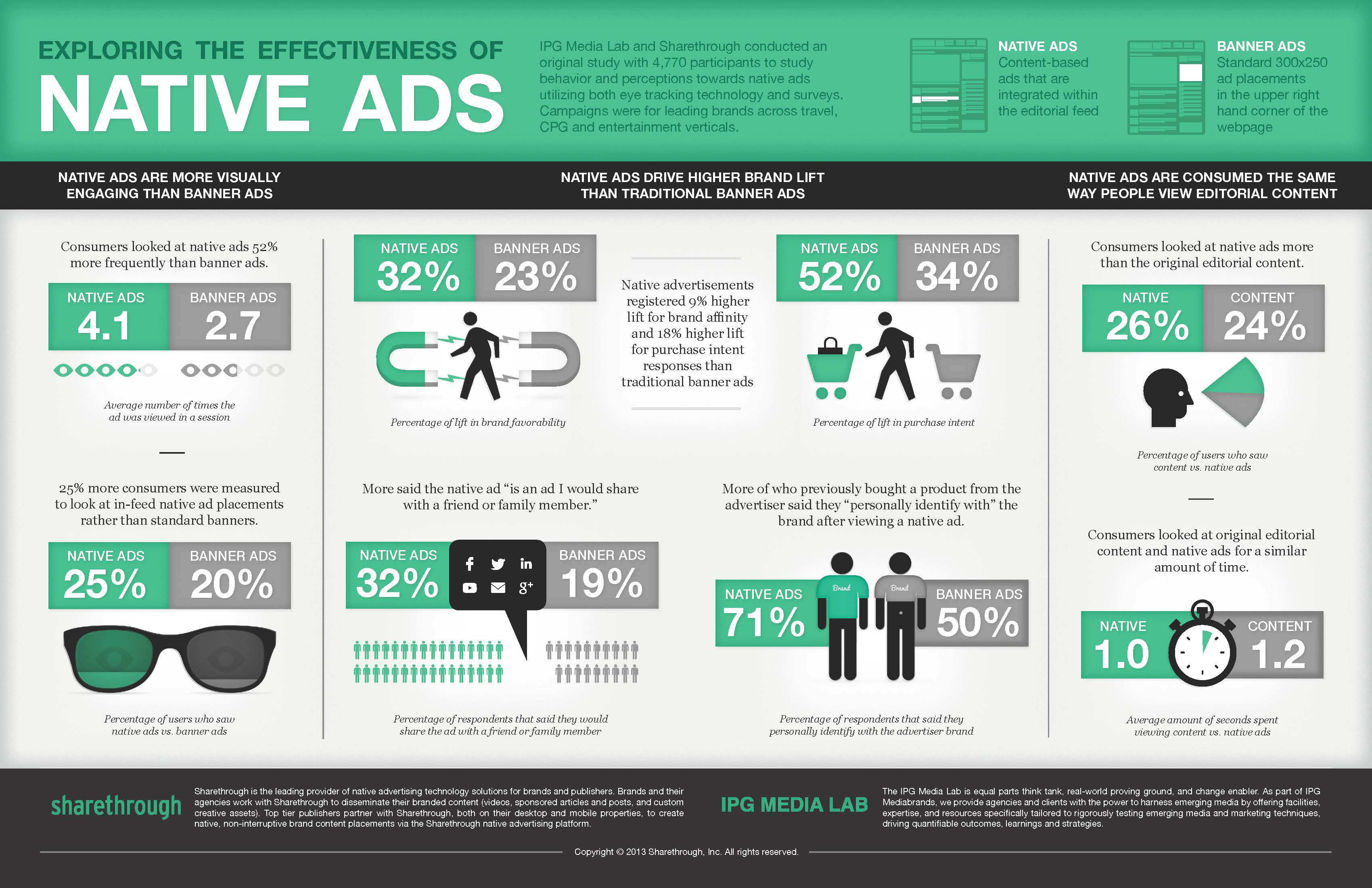
Definitions of native advertising still vary
Native advertising has seen a growing chorus of interest among publishers and ad buyers. Integrating sponsored content into digital channels has opened new doors for marketers to reach distracted consumers and provided publishers with new opportunities to generate ad revenue.
According to a June 2013 survey from the Online Publishers Association (OPA) and Radar Research, while many publishers may still be experimenting with how and what native advertising they will offer, most have already rolled out some native ad opportunities. Nearly three-quarters of polled US publishers said that they already offered native advertising on their site, and another 17% said they were considering offering it this year. Only 10% had no native ad plans of any kind.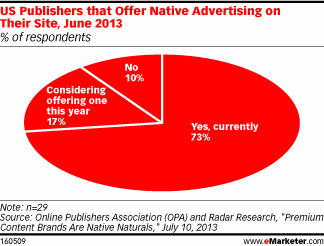
But even as more publishers roll out native advertising, there is still variation in how they think about and begin to define the new ad products. Nearly all publishers attested to the most essential definition of native advertising as “integration into the design of the publisher’s site and [an ad that] lives on the same domain.†And nearly nine out of 10 also said that native advertising was “content produced in conjunction with the advertiser, or by the advertiser, that runs within the editorial stream.†A slightly lesser 79% believed native advertising must be clearly delineated and labeled as such.
These may be crystallizing as the central tenets of native advertising.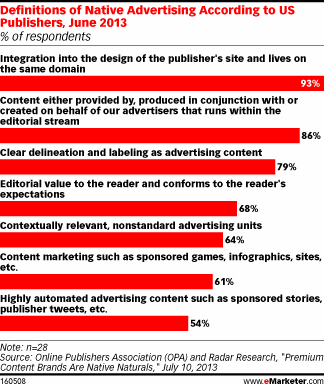
To evaluate their native ad campaigns, publishers said engagement was the leading metric marketers used, cited by 57% of respondents. That was followed by traffic, at 43%. Social sharing came in at one-third of respondents, indicating that while advertisers may want to get consumers sharing their native ad posts, this is not their No. 1 priority.
Market research company BIA/Kelsey estimated in April that this year, US native ad spending on social sites will reach $2.36 billion, or 38.9% of total US paid social ad expenditures. By 2017, social native ad spend will grow to $4.57 billion, and its share of social spending will inch up a few percentage points to 41.7%. But with native advertising reaching into so many digital channels besides social, this is likely far below the total outlays that will go toward native ads in all their different iterations.
eMarketer
DealerNet Services
 By using an omni-channel approach, the Topshop brand has generated a year’s worth of average Facebook activity in just four days. Photograph: Kin Cheung/AP The exponential growth of digital has created an environment that 20 years ago didn't exist, and even today we are still finding our way around it.
By using an omni-channel approach, the Topshop brand has generated a year’s worth of average Facebook activity in just four days. Photograph: Kin Cheung/AP The exponential growth of digital has created an environment that 20 years ago didn't exist, and even today we are still finding our way around it.Young people have grown up in this digital environment and are unafraid to use it. What is clear is that if we want to survive and prosper in this new digital era, we need to look at not only what it can do for our brands, but also what it can't.
And the one thing that online can't reproduce is the physical interaction between your consumer and the product. Offline gives us the opportunity to fulfil other senses that are involved in making a purchase. A physical place is somewhere to return a product, to have a conversation with someone face-to-face. It's a place where an issue can be resolved immediately. Online customer service has a lot to live up to.
In a recent survey, 60% of respondents said that they expected converged retail channels to be the norm by 2014. But more than half of shoppers said that most retailers lack consistency in the way they present themselves across channels.
Your customers will trust someone who is reliable, consistent in what they say, how they say it and what they promise. But more importantly, they expect to have the same brand experience wherever and whenever they interact with your brand.
The future is omni-channel By 2014, nearly everyone in western Europe and the US will have access to a smartphone connected to the internet. The world is already populated by brand-savvy consumers who are now in control. They say where and when they want to shop, and in some cases, what they are prepared to pay for a product. Retailers can't afford to let any moment of their customer brand experience to be less than rewarding, responsive and reliable.
The future is omni-channel: a mix of all the different ways people like to shop, blended together but all saying the same things. This means in store, on the web, through mobile, TV and social media.
Global research expert Forrester has speculated that the future consumer will want not just responsive interactions but adaptive ones, with content delivered in a way that best suits them as individuals, and their particular device.
Digital experiences will need to be more contextual, possibly including location, purchase history and recommendations. Devices will sync together and with other products allowing people to order from one device and check progress of delivery from another. And information visualisation – shortened to "infovis" – will need to be mainstream.
Brands taking the leadAlthough this digital integration is still in its infancy, some brands are already beginning to adopt it, including Burberry, Topshop, Hollister and M&S. Topshop recently launched a campaign where shoppers received a free styling and make-up session and were invited to create a digital 'Wish you were at Topshop' postcard using Instagram.
Once the postcard photo had been taken, they were given a copy to take home and were also able to upload it to Facebook and the Topshop gallery. To date it has generated 640 blog posts, with a reach of 1.4 million, as well as 5.3m views on Facebook and 2,000 comments. That's a year's worth of its usual Facebook activity in just four days. And as a result, it has become the number one fashion retailer on Instagram.
Or take M&S, a stalwart of the high street, yet embracing online and offline integration with Wi-Fi in store. The brand is also investing in connecting mobile web to the in-store experience. M&S sales assistants will carry tablet devices, and touchscreen kiosks are placed throughout stores to engage shoppers and make customer service easier.
If all channels are connected, customers can start their journey on one channel and complete it on another, creating seamless experiences that increase convenience and engagement, and with consistent brand experience.
Written by Max Eaglen
DealerNet Services
 Brands, companies, and individuals -- I think it’s time for some real-talk about content and social media. Gary Vaynerchuk recently gave an interview about his decision to employ a full-time stalker (a.k.a “content personâ€) to chronicle, translate, and transcribe his every movement and remark into micro-content for various social media.
Brands, companies, and individuals -- I think it’s time for some real-talk about content and social media. Gary Vaynerchuk recently gave an interview about his decision to employ a full-time stalker (a.k.a “content personâ€) to chronicle, translate, and transcribe his every movement and remark into micro-content for various social media.While I respect Vaynerchuk’s incredible success and agree with his sentiment that micro-content and content in general is incredibly important to the future of business, I question whether encouraging brands and companies to develop this type of content is really what leaders in the social world should be doing.
This massively successful Slideshare presentation speaks to the already overwhelming amount of useless content we experience on a day to day basis. It states that “the single greatest threat to content marketing is content marketing.†The deluge of shoddy, slapped-together content and micro-content that content shops, farms, and agencies are churning out in an attempt to keep up with the growing desire for more and more media is actually what is making us (the collective number of people “listeningâ€) numb to content of quality.
I’m beginning to notice a “content double-take,†where readers are so glazed over scrolling through endless LOLcat updates and tweets about food that they almost (or sadly, sometime do) miss an incredibly important piece of content and have to scroll back to it after the few seconds it takes to sink in.
For instance how many reading actually know what’s happening in Turkey? Or that ExactTarget was acquired by Salesforce for billions of dollars? Or any equally important, business-specific update. I am totally guilty of this “double-take†predisposition and I’ve often missed opportunities to learn, grow as a consumer of content, and be informed about important, bottom-line impacting events. I’ve missed the chance to provide immense value to my community because of precisely the type of content Vaynerchuk is championing.
Do we, the brands and companies with the resources to develop consistent streams of content, want to build a culture of “fast food consumerism†around content and social media? Do we want to actively encourage QWERTY-vomit instead of meaningful, thoughtful insights that could actually benefit another human? Do we want to say without words that “fast and easy†holds more value than “thoughtful and creative?†Should the leading voices in this space really be creating and supporting this type of content?
I don’t think so.
We, as a collective, should be focusing on creating a smarter, more beneficial internet -- for everyone. Web media and the internet’s immense index of knowledge is fundamentally changing the way we learn and communicate across the world. It is the unspoken responsibility of those creating and pushing content (especially from high places) to not muck that up! A recent survey shows that 67.5% of professionals use social media to find and consume content for professional reasons every single day, and this percentage will only grow as more people around the world get connected to social networks.
It is our responsibility to do more, be better, and produce higher-quality resources than we did yesterday. People all over the world are looking to us, as leaders, for inspiration, guidance, and insight -- that they could follow in our footsteps and also be more than the sum of their parts. Failing to recognize this, or recognizing this fact and choosing to ignore it for the “easier†path, is negligent, insular, and selfish.
You may be saying to yourself “well, all that idealistic ‘we can make the world better’ sentiment is nice and all, but I really just care about my bottom line.†I respect your position as a business person but, unfortunately, the point that value and insight should be driving your content development still stands (see above, where 67.5% of professionals use social media to find and consume professional content every day). Diluting the landscape with meaningless drivel produces a more complex, chaotic content landscape that will actually make people pay attention to you less, which, at the end of the day, is the opposite of what we (as brands and business) want.
Let’s be real. More likely than not, if you are reading this, you are not in that top “1-5%,†which means you already have to go above and beyond to be heard through the noise on social media and the web in general. Do you really want to make this more difficult for yourself? Do you want to become a monotonous voice of constant, meaningless communication in a sea of identical monotonous voices or do you really want your message to shine and drive significant impact? Consider this: a recent poll of professionals on the Scoop.it platform presented data that one piece of high-quality content had brought in over $50,000 on average over the lifetime of that content.
A more organized and valuable internet benefits the world, our brands, and our future leaders for the long tail -- not just the short-term vision of the “top 1-5% of executives and social media personalities.†Random updates from the days of these top 1-5% won’t spark creativity or innovation -- the absolutely priceless insight and perspective which the positions of this top 1-5% afford them is what will inspire and help create the leaders of tomorrow. Brands and personalities should be known for who they are, what they stand for, and what they are best at -- not who can create the biggest firehose of social media data.
Who am I to say these things? No one, just a humble content person with a bigger vision for social media and content than tweets with no vowels. Someone who was inspired to do this work because of the incredible insights and sincerity I saw from the brands and online personalities that catapulted social media to its position in the ecosystem of the internet today.
I ask you, brands, companies, and individuals as a peer and fellow creator -- do you want to be remembered because you had amazing, beautiful, insightful things to give to the world or do you want to be remembered because you just wouldn’t shut up? The choice is yours.
ByClair Byrd
DealerNet Services
Most C-level Executives, CMO included, View “Social†as Media but…
Tags:
 Most C-level Executives, CMO included, view “Social†as media—but they don’t know how to interact with consumers there in a meaningful way. They want to buy CPMs or Likes—but don’t know what to do with them afterward.
Most C-level Executives, CMO included, view “Social†as media—but they don’t know how to interact with consumers there in a meaningful way. They want to buy CPMs or Likes—but don’t know what to do with them afterward.
CMO’s also make the mistake of assuming that the social audience has the same pain and passion points as their face-to-face or store audience. Most often that is not the case.
In order to get the real value out of Social, you must connect emotionally to the people who are there and find out what they’re looking for. CMOs are used to ads and campaigns, so that’s the place they gravitate, but even Facebook ads are only media buys. Ads are good for building initial likes, but they really are targeted to demographics just like any other ad.
Your mission is to go beyond that initial like and really get people excited about your brand, engage with you, buy from you, become a social advocate and sell for you. To do that you need to get into the heads of your social buyers.
So assign that as a singular goal to appropriate personnel on your team. Make it their mission to follow or friend your followers (not only on Facebook and Twitter, but everywhere online) and listen to their conversations. Their sole mission should be to pay attention to your social consumers. Find out what they like to talk about, the other brands they like, what their problems are–what makes them tick. That’s not a one-and-done task either… it’s ongoing.
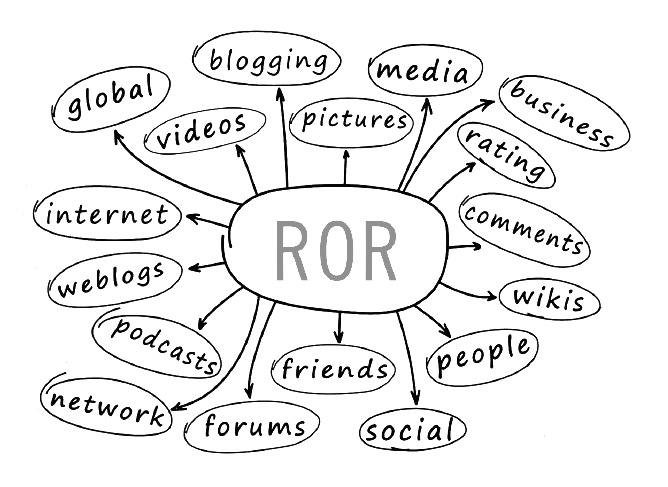
by Ted Rubin
DealerNet Services
 Have you noticed that more and more ads have been creeping into Google’s search results over the last few years? The result is that all the actual search results (known as “organic†results) are being pushed further and further down the page. The Problem In the screenshot below you can see the Google Ads highlighted in the red rectangles. This is what the Google results page looks like if I search for “Brisbane mechanic†on a laptop with a screen resolution of 1280×800, which is fairly common for 14″ or 15″ laptops (different screen resolutions will show more or less of the results page). As you can see, only two organic results show on the page without needing to scroll down. The content that shows at the top of the page without having to scroll down is known as being “above the fold“. In the same space there are SIX ads! Not to mention the ads get pride of place at the top of the screen, encouraging more people to click on them.
Have you noticed that more and more ads have been creeping into Google’s search results over the last few years? The result is that all the actual search results (known as “organic†results) are being pushed further and further down the page. The Problem In the screenshot below you can see the Google Ads highlighted in the red rectangles. This is what the Google results page looks like if I search for “Brisbane mechanic†on a laptop with a screen resolution of 1280×800, which is fairly common for 14″ or 15″ laptops (different screen resolutions will show more or less of the results page). As you can see, only two organic results show on the page without needing to scroll down. The content that shows at the top of the page without having to scroll down is known as being “above the fold“. In the same space there are SIX ads! Not to mention the ads get pride of place at the top of the screen, encouraging more people to click on them.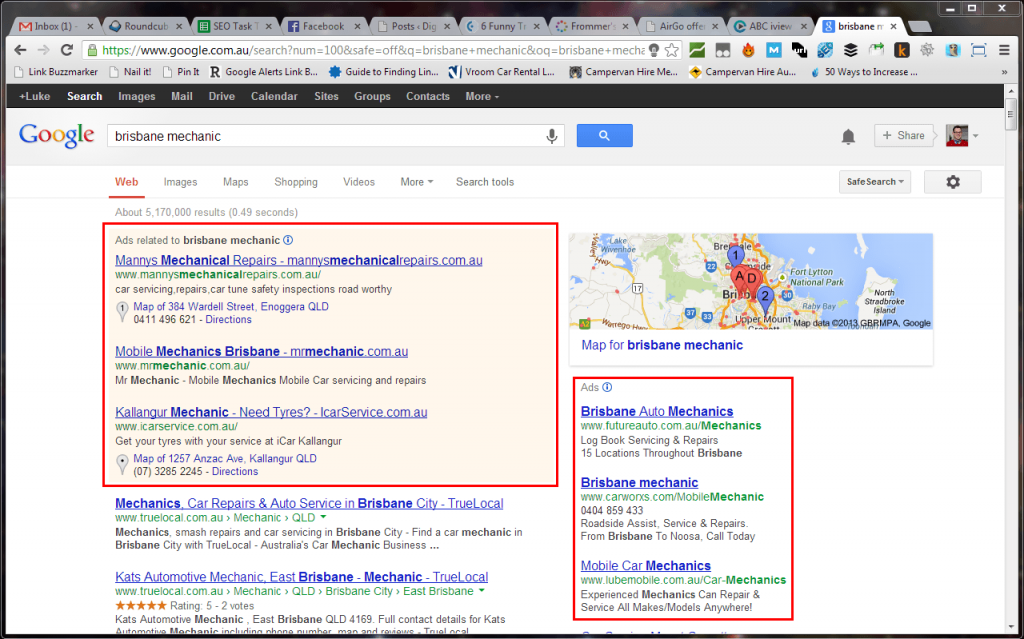
For some results there aren’t ANY organic results above the fold. That means everything you see after you search is advertising!
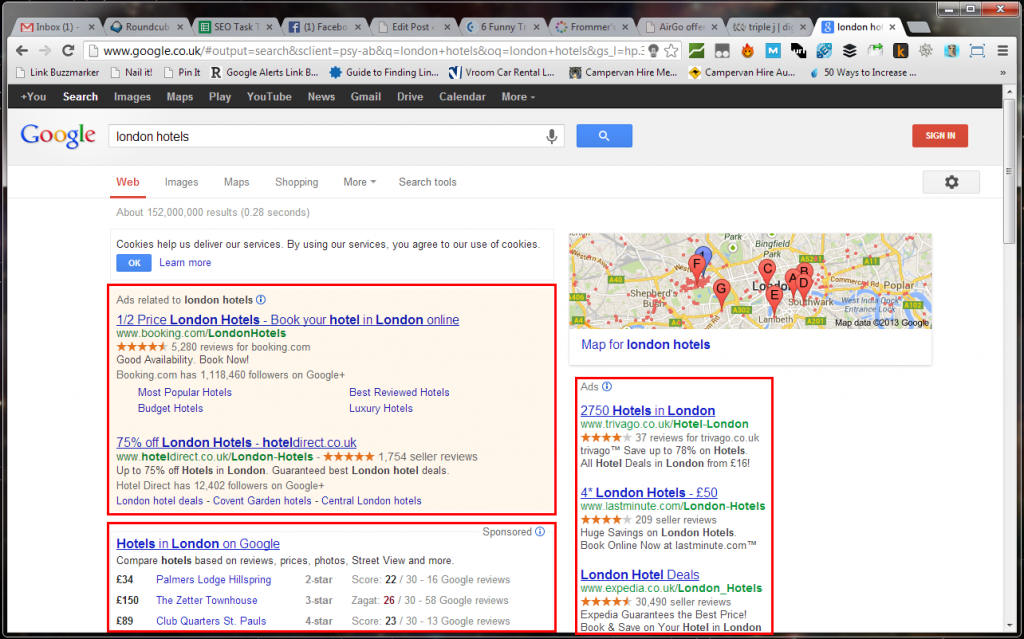
What Else Can I Do? “I want to rank number 1 on Google†is not a valid digital marketing strategy. Even less so now that the actual organic listings are being pushed so far down the page. The good news is there are so many other things that you can be doing to improve traffic to your website other than “traditional†SEO. Here are some ideas to get you started.
- Embrace social media. I don’t mean go and post funny cat photos on Facebook. I also don’t mean to go and buy a bunch of fake Facebook likes on Fiverr. I’m talking about actually being social. This gets right to the heart of what social media is about. Do some research and find out where your target market is active online – is it Facebook? Twitter? Pinterest? TripAdvisor? The answer will vary depending on your industry and the demographics of your target market. Once you know where your target market is, go and be social with them! Think about what that means. Is standing on a soap box yelling about your latest products or services “being social� No! Yet that’s exactly what most companies do on their social media accounts. What you should be doing instead is being helpful, getting involved in conversations and solving people’s problems.
- Become the authority for information or news on your topic. Seek out and write for relevant publications that may reach your target audience. A good way to do this is to look on websites like SourceBottle for journalists and bloggers that are seeking sources for their articles. Get in contact when they’re looking for something that you can help with, and you’ll often end up in a magazine, newspaper or on a website appearing as the expert on a certain topic, with a link to your website.
- One of the best ways to get extra exposure and PR is to network with other people in the industry, and with opinion leaders. Do the groundwork and build up these relationships and it will pay off in the longer term. If you need help with networking, I’d highly suggest reading Never Eat Alone by Keith Ferrazzi.
- Make the most of your existing customers and website traffic by getting them to sign up to regular e-mail newsletters. Once a month or quarter may be enough, depending on your website. Don’t send out updates just for the sake of it. Offer something interesting, insightful, newsworthy and/or funny. This will keep people coming back to your website and keep your brand front-of-mind.
- Find relevant blogs and comment on them. You’re not commenting for the power of the backlinks, but once again to help build your name as an expert and someone helpful. Be sure to use your name (not your company name) as this will make it much easier for people to relate to you, and you’ll come across as much more genuine and approachable.
- Go the extra mile for your customers. Word of mouth always has been (and still is) one of the most powerful forms of advertising you can get. Your customers will become advocates for your company (and website)!
- Branding is super important. Make sure your brand is consistent and easily recalled by customers. A nice clean website design is also important, as bad design can result in visitors clicking the back button straight away. Come up with a great tagline or business name and it will stick in people’s minds much longer. Guess who they’ll think of when they need the product or service that you provide?
by Luke Chapman
DealerNet Services
Reeling Them In! How to make your Website Work Harder For You
Tags: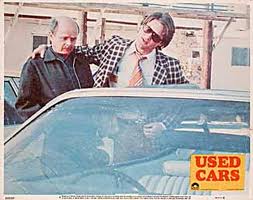
Previously seen as an afterthought, more companies are seeing the value to be had in actively improving their website.
Is your company’s internet presence going unnoticed? This might be because what you thought was the hard part, has only just begun. These days it’s not enough just to simply have a website to bring in visitors, you have to actively make it an attractive destination for consumers who are surfing the web. The Internet can play an important role in marketing your business, however you have to know how to make it work for you.
Your online presence can be seen in two phases. The first is successfully bringing people to your page, while the second is keeping them there long enough for your message to have been communicated. The following are some tips that can both increase the traffic that is coming to your site and encourage people to continue looking once they have arrived.
Reeling them in
Events on the Internet happen in the blink of an eye. This means that you need to keep your website fresh and up to date if you want to see it coming to the top of the Google and Bing searches. Strategies like maintaining a blog or a current news feed are easy ways in which to keep the content on your website fresh and give people new reasons to visit your site.
Having said that, it is important to keep the content you publish meaningful. If you are simply posting the same thing using slightly different terminology, not only are you compromising the quality of your website, you are not doing meaningful work to improve your website’s search engine optimization, as search algorithms can decipher deliberate attempts to put as many keywords on your website as possible. But if you truly believe the work that you do is important and can offer invaluable service to your customers, content should be able to flow with a little bit of insight.
Keeping visitors engaged
So you having given them a reason to visit, the challenge is being a good host and giving your guests a reason to stay. Inc. Magazine explains that websites can be viewed in a sense like newspapers. In the “olden days†of hardcopy newspapers, the attention grabbing news stories would be listed “above the fold,†meaning they would be the first thing that a reader saw so as to draw them into the paper. This concept can be applied to your website as well, by making the most attention grabbing and attractive pieces of content the easiest to access. It is only so much to have a great piece of content – you have to put it in a place that makes visitors want to see it.
Software can now point out where the highest and lowest amounts of traffic on your website are arriving, and in doing so, see what sections are receiving the most action. If you notice that a particular page is not being visited nearly as much as others others, you may want to consider where its short comings lie. It could simply be that it is in a difficult to reach spot or it could be that people are not interested in the information it has to offer. This should prompt you to evaluate what it is this particular page is doing for your site. If you feel that information is important for your visitors, it should be put in an easier to access location, but if you feel like it might be extraneous, it probably is.
A website is all about giving potential customers a reason to visit and a reason to stay. What forms of content have you used to accomplish these goals?
Article by by Chelsea Segal Intro by DealerNet Services
(Part 3) There Is More To This Content Marketing Than Just Clicking Publish
Tags:
 Why did this work so well?
Why did this work so well?
When someone is featured on another website, it can have a profound effect on their social following.
It shows that they are more of an authority on a subject because more people value their opinion.
The more times you’re featured and the more times your opinion is validated, the more of an authority that you will be perceived to be in the eyes of your followers.
Also, when you create an extremely valuable resource generally people are more inclined to share it because they know their followers will find value and appreciate the content being shared with them.
When someone is featured in an extremely valuable resource alongside some other big names, especially people that they look up to then they are compelled to share the content with their following and in some cases even go out of their way to share it more than they would with a regular mention.
I must warn you, not every person you include in a post like this will share and you will get varied results depending on the niche or industry that you operate in.
Â
What other types of content can you use?
Regular blog posts, interviews, group interviews, industry roundups and infographics all work well.
The rule of thumb here is that generally, the more people you involve in your content, the more potential people that might promote it.
Â
#3 – Build and maintain relationships with influencers and industry peers
A lot of people approach this blogging thing like it’s something you can do without any interaction or involving other people at all.
It used to be the case that people would just setup a blog, fire a load of rough content up and blast as many anchor text optimized links at their site as possible to rank in Google and then just sit on a beach somewhere without doing a thing – just sipping back mojitos while their bank account fills up with money.
For a time it worked and people made bank, we’re talking obscene amounts of money – but the problem that they have now is that Google has forced people into making effort, writing good content, building good links and generally treating our business the way it should be treated.
Whether your blogging to earn money, run an offline business or something else – the shortcuts don’t exist anymore.
Well, that’s not exactly true because there are certain verticals that are still dominated by spam, partly due to the fact that Google treats different industries differently, the ranking signals for one industry can differ drastically to another – but those that are still using nasty link building won’t get away with it for much longer.
Google left the door wide open and people saw an opportunity and for a lot of businesses it was a case of either use nasty link building tactics, rank and earn money or don’t use those tactics, don’t rank and don’t earn money.
People weren’t thinking of the big picture and it boils down to this – the user experience, whether it’s a slick site that gives you a great experience or a site that people simply find valuable and learn a lot from.
You need to get social, you need to connect and network.
Business owners have networked for years offline and used it to pass business to each other and generally help each other out – it’s worked great and it works great online too.
Â
Â
Â
And here’s a 5th – if you want to connect with bloggers directly and get a lot more shares on your posts then get involved by joining Triberr and be part of my Tribe.
BYÂ Adam Connell
Â
(Part 2) There Is More To This Content Marketing Than Just Clicking Publish
Tags:
 #2 – Feature or write about industry influencers
#2 – Feature or write about industry influencers
When you start any content marketing campaign, one of the first things that you should do is map out the influencers in your industry – think about the type of people that you follow and whose opinion that you value.
I recently published a group interview on my blog where I invited a number of industry experts to talk about how they build reader engagement with their audience. You can view the post here.
I started by inviting a number of influencers within the marketing industry to answer a number of questions on improving reader engagement – something that all of the people I asked did very well.
In the end I managed to publish responses from Seth Godin, Anita Campbell, Neil Patel and 30 other industry experts.
Â
What did I do to promote it?
I reached out to everyone that took part using social media sites such as Twitter and Google Plus – sites that would notify them that they’d been mentioned.
This was then followed up with an email to let the participants know that the post was live, where they could find it along with a call to action.
The call to action was to help share the post and vote for the post on BizSugar.
The post was then imported into my Triberr account – If you’ve not come across this before, it’s a platform that allows you to link up your Twitter profile (along with Facebook and Linkedin) and join tribes of like-minded bloggers, marketers or business owners that will see your content and get the opportunity to share it with their followers.
Â
What about the results?
In just over a day the post was the 2nd most popular post on BizSugar in June:

The post has gained quite a significant amount of traction on social media:

The post also earned some good links according to Ahrefs.com (Majestic shows more referring domains, but I prefer the graph in Ahrefs):
It also helped me get contributor of the week on BizSugar.com:

You can find the post here.
Continued Part 3:
http://onebigbroadcast.com/autospeakstraighttalk/view/287/_Part_3__There_Is_More_To_This_Content_Marketing_Than_Just_Clicking_Publish.html
http://dealernetservicesonline.biz
There Is More To This Content Marketing Than Just Clicking Publish (Part 1)
Tags: Content marketing has already proved that it can be a powerful way of building your brand visibility and generating leads but a lot of marketers continue to talk about creating great content like it’s the only thing that you need to do when there is so much more to it than that. The truth is that clicking publish is not enough and it never was.
Content marketing has already proved that it can be a powerful way of building your brand visibility and generating leads but a lot of marketers continue to talk about creating great content like it’s the only thing that you need to do when there is so much more to it than that. The truth is that clicking publish is not enough and it never was.I’m sure you’ve seen it, marketers with blogs that are that popular that they only need to click the publish button and wait for all the tweets, likes, +1’s and links to poor in.
When someone is in a position like that, it’s easy for them to forget that for most bloggers, marketers and business owners – clicking publish just isn’t going to
Paul May from BuzzStream did a great job of highlighting the reality about content marketing here and mentioned a number of important points that really ring true.
The main one being – for the majority of us, if we want to get traffic, social shares and links when we publish a post then we’ve got to go out there into the world wide web and actually promote our content.
Some of the best content is left to gather dust in the far corners of the web simply for the fact that it hasn’t been promoted.
Surely, you would want to make your content visible rather than letting it sit there right?!
Below I am going to show you a number of tactics that you can use to get your content visible to the right audience along with some examples of what has worked well for me and what I believe can work well for you.
Â
#1 – Put the right content in front of the right people
Knowing who exactly you are targeting is extremely important in business and it’s extremely important in content marketing too.
If you know exactly who it is that you’re targeting then you can find their online hang outs, who is active within the industry and how you can put your content in front of them.
The other side of this is writing content that you know will be a hot topic for your target audience and cause some debate – which ultimately leads to more traffic, more shares, links and visibility.
A few months ago, the marketing agency I manage launched a new service, content marketing was one of the tactics that we were focusing on and our MD, Jason Brooks wrote an opinion piece that threw the question out there – “Is Google+ The Key to Building Links with Guest Post after Penguin 2.0?â€
Â
How did we promote it?
We shared the content using various social media channels such as Twitter, Facebook and Google+1.
We also shared the post on several niche social networks, including BizSugar and Inbound.org.
The post was then imported into my Triberr account – If you’ve not come across this before, it’s a platform that allows you to link up your Twitter profile (along with Facebook and Linkedin) and join tribes of like-minded bloggers, marketers or business owners that will see your content and get the opportunity to share it with their followers.
Â
What about the results?

Above image taken using Linktally to generate the tally of shares.
Â
Why did this work so well?
Considering the site is a few months old and doesn’t have many posts this is quite impressive but there are a few things that immediately stood out:
- The majority of our following on Google+ and Twitter consists of marketing agencies and industry professionals from the marketing and SEO space
- The post also caused a lengthy debate between a number of people in Google+ which resulted in traffic, further discussions and shares
This shows that when you target the right people with the right content you can cause a stir, get a conversation going (in this case on Google+ mostly) and ultimately get a great deal of visibility that you wouldn’t get under regular circumstances.
Part 2 Continued
http://onebigbroadcast.com/autospeakstraighttalk/view/286/_Part_2__There_Is_More_To_This_Content_Marketing_Than_Just_Clicking_Publish.html
 Marketing has been democratised.
Marketing has been democratised.
The capability to use marketing tools and technology without having to beg or pay for attention is unprecedented. It’s a time where you can now build your own crowd to market and sell to without paying the mass media gate keepers.That’s social media.
The social media networks are at your disposal and with the right tactics and software you can create brand awareness and access to influencers and decision makers in boardrooms across the world.
This freedom to take control of your own marketing comes at a cost. The cost is complexity and time. To be effective it requires using multiple networks, constant content creation and monitoring and managing.
It’s not just multiple networks and multimedia to think of, it is also about adapting to new hardware platforms where consumers receive their messaging. This is no longer restricted to just print, TV and radio but has proliferated to laptops, smart phones and tablets. They all have their own limitations and parameters to be optimal.
Within this technology and media explosion there are many marketing trends that have been emerging that we should be paying attention to.
7 Marketing Trends
Here are seven trends that all marketers need to consider in their toolbox of tactics to remain effective and current.
1. Content marketing
The importance and role of content marketing and how it works across social media, search, multimedia and mobile is becoming a key focus for many brands. Many companies don’t understand the importance of this trend and how it underlies almost all digital marketing. Brands such as Coca Cola have recognised this and changed their strategies to meet the web realities.
Brands have been blinded by the shiny new toy of social media eg Facebook and think that Facebook marketing is all they should be doing beyond their day to day habitual marketing that they have been doing for decades.
This is just a snippet of your activity focus. You should not be forgetting Twitter, Blogs and Google+…just to mention a few to market your content.
Content is the foundation of all digital marketing and is the reason people read, view or share.
Creating “liquid content†is vital to create brand awareness and tap into crowd sourced marketing.
2. Mobile Marketing
The rapid rise of smart phones and tablets has flatfooted many marketing managers and delivering marketing messages and content that is optimized for mobile platforms is becoming a “mustâ€. Increasingly consumers are viewing content, receiving emails and buying products from “small screensâ€.
Companies need to urgently redesign websites and blogs that are “responsive†(respond to all devices screen sizes for optimal viewing and usability) to ensure they are optimising for mobile devices. Some websites are recording 30-40% of all traffic from mobile devices. That should not be ignored. It will cost you money and lead to missed opportunities.
3. Integrated Digital Marketing
Companies that are savvy marketers are realizing that digital marketing should not be one offs that are islands of isolated tactics. Social media and content is impacting search results. Google created Google+ for a few reasons including capturing social signals. Ensuring that your approach is allowing you to tie them all together to achieve maximum effectiveness is becoming key.
This is optimised and integrated digital marketing.
4. Social Media at Scale Marketing
Brands are also realizing that “doing†social is complex and is like juggling many balls at once. We are seeing the rush to develop, buy up start-ups and implement Enterprise platforms that are assisting marketing professionals to market, manage and monitor multiple social networks and even other digital marketing (eg email).
The tools to manage the complexity are emerging and evolving as the rush to package the technology accelerates. The holy grail to have one tool to manage your marketing is the mission for many software companies who see this opportunity.
This is “social at scaleâ€
5. Continuous Marketing
Marketers need to realise that a strong trend is emerging called continuous marketing. It doesn’t mean that you shouldn’t run “campaignsâ€. The reality is that being found online (found in social network updates, Twitter streams and in a Google search) requires constant SEO activity and content creation, publishing and marketing.
Google hates silence.
Creating, curating and marketing content that is fed into the maws of the social media beast needs to be relentless or you will left behind and you will be lost in the web noise.
To do this well requires implementing marketing automation that leverages your time and resources.
6. Personalized Marketing
The “one size fits all†approach to marketing where mass messages on television and traditional media are becoming less effective due to media saturation. We are seeing the rise of personalized marketing on e-commerce sites, websites and emails that tailor the advertising and user interface to the relevant interests of consumers.
Visit an online store once and come back and the website knows that you are male and like Nike runners. The next email that arrives has also been personalised with products that you visited while shopping online. The web is capturing your habits as it reads the data, applies intelligence and serves up information that is relevant to “youâ€.
This trend is being driven by technology using “big data†to increase marketing effectiveness.
7. Visual Marketing
We first saw the creep of visual marketing into the landscape when YouTube entered mainstream consciousness a few years ago. Since then this creep has turned into a torrent of visual marketing with emergence of Pinterest, Instagram and even Slideshare.
In the last 6 months this has gone to a whole new level as Vine’s 6 second snack size video and now Instagram’s new 15 second video app has marketers scrambling for creative inspiration to apply and leverage this new trend.
Your marketing needs to ride this trend to increase engagement and cut through the online noise.
What about you?
Which trends excite you or even surprise you? Have you adapted your tactics to meet the continual marketing and technology eveolution.
Look forward to hearing your stories, feedback and insights in the comments below.
Written by Jeff BullasÂ
http://dealernetservicesonline.biz
Â
CALENDAR
CATEGORIES
TAGS
TWITTER POSTS
CALENDAR
- powered by
- One Big Broadcast
- creative by
- WebStager
© 2025 One Big Broadcast | All rights reserved


